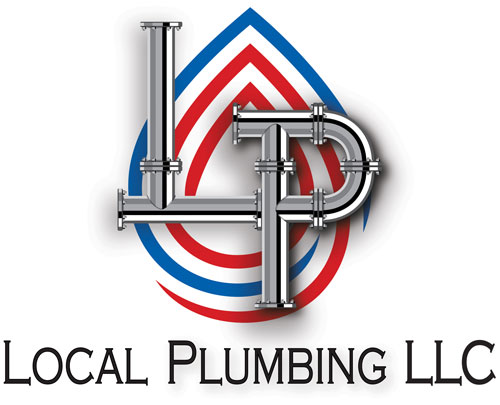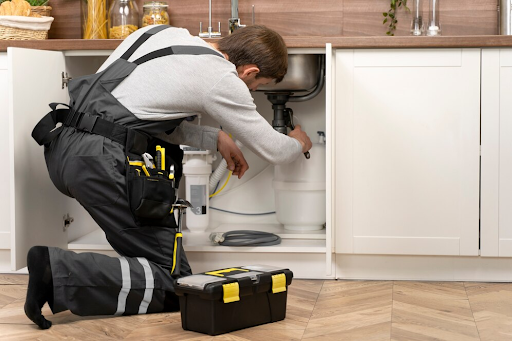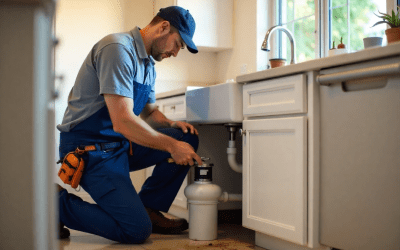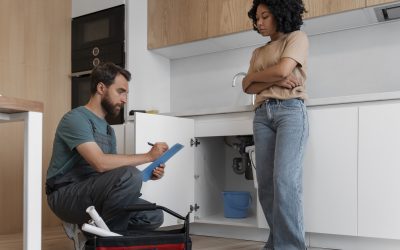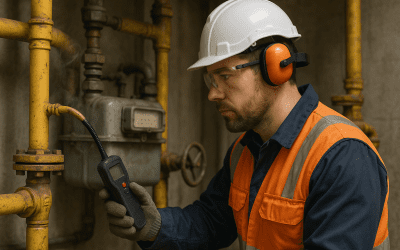In this guide, we’ll break down the most common kitchen plumbing problems and show you exactly how to fix them, before they get out of hand. So, roll up your sleeves, grab a wrench, and let’s get your kitchen running smoothly again!
7 Common Kitchen Plumbing Issues and How to Fix Them
Clogged Sink Drains
When food particles, grease, soap residue, and other things accumulate in the pipes, they restrict the flow of water. With time, this leads to complete blockages and calls out for the worst nightmare of people, standing water in the sink with all the germs and bacteria from the pipe.
Here’s how to fix it:
Use a plunger to create suction and dislodge the clog. Once the water is clear, add a good amount of baking soda to the drain and let it settle. After 5 minutes, add vinegar and let it react and clear out all the dirt and grease that it stuck in the pipe. After leaving it in for 10 minutes, pour boiling water to clear it out.
Leaky Faucets
Leaky faucets may seem to be a small issue, but they can give a very high rise on your water bills and damage your items if left unsupervised. This usually happens when some components inside the faucet are worn out; it can include a washer, valve seat, or even corrosion due to the minerals depositing from the hard water.
Here’s how to fix it:
Turn off your water supply and take the faucet out. Once you open it, there are three things you need to check:
- Inside the faucet handle, you will see a round ring-like thing. If it seems loose, replace it.
- Clean or replace the valve seat if it’s corroded.
- If the faucet is old, consider replacing it with a new, water-efficient model.
If the leaks are persistent, you can always call for a professional plumber in Cibolo, Schertz, New Braunfels, San Antonio or any other surrounding areas.
Low Water Pressure
Weak water flow from your kitchen faucet can make washing dishes and cooking difficult. This issue is often caused by blockages in the aerator, water-line problems, or pressure issues in the main water supply.
Here’s how to fix it:
- Clean the aerator: Unscrew it from the faucet, soak it in vinegar, and scrub off any deposits.
- Check the shut-off valves: check if they are fully opening to allow maximum water flow.
- Inspect for leaks: Look for signs of leaks under the sink or in the main water line leading to your kitchen.
Garbage Disposal Problems
If your garbage disposer is not turning on and keeps making grinding noises. This could be due to a jammed blade because of fibrous food or bones, electrical issues, or clogged disposal from improper waste disposal.
Here’s how to fix it:
- Press the reset button on the bottom of the disposal unit.
- Use an Allen wrench to rotate the blades and remove jams.
- Avoid disposing of fibrous foods like celery, potato peels, or coffee grounds in the disposal.
- Flush with ice-cold water after every use to clear debris.
Leaky Pipes Under the Sink
Due to a loose connection between the pipe and joint, faulty fitting, or corrosion, your pipe tends to leak underneath the sink. These leaks can lead to a very unhygienic kitchen as they attract bugs, grow mold, and even cause water damage to the other parts of the kitchen.
Here’s how to fix it:
- Apply plumber’s tape to minor leaks in pipe joints.
- Replace damaged pipes or fittings if corrosion is present.
- Check the P-trap (curved pipe under the sink) for blockages that may cause leaks.
Dishwasher Drainage Issues
If your dishwasher doesn’t drain properly, it can leave standing water inside the appliance, leading to bad odors and poor cleaning performance. It may be due to a clogged drain, a blocked airgap, or a failing drain pump.
Here’s how to fix it:
- Inspect the dishwasher filter and clean out food particles.
- Check the drain hose for clogs and clear any obstructions.
- Ensure the air gap is clear to prevent backflow issues.
Water Heater Issues Affecting Kitchen Plumbing
If your kitchen sink isn’t supplying hot water, there could be some issue with your water heater. In an electric water heater, the inner elements could have malfunctioned, hard water sediments could build up in the tank, or a faulty thermostat could give you inconsistent water temperatures.
Here’s how to fix it:
- Flush the water heater tank regularly to remove sediments.
- Check the thermostat settings and adjust them if necessary.
- If your heating element is defective, replace it.
Essential Tools for DIY Kitchen Plumbing Repairs
These are some of the tools that are necessary in every household to tackle the small plumbing issues of your kitchen. Here, we have listed some of the tools that you must have for kitchen plumbing repair:
- Wrenches: There are three different types of wrenches that you’ll need:
- Pipe Wrench: A heavy-duty wrench used to grip and turn pipes and fittings while fixing any leaks.
- Adjustable Wrench: It is a versatile tool used for tightening and loosening nuts and bolts on kitchen plumbing fixtures.
- Basin Wrench: A long-handled wrench that reaches and tightens nuts in hard-to-access areas under sinks.
- Plumber’s Tape: It is also known as Teflon Tape. This is a thin tape used to seal pipe threads and prevent common leaks.
- Pipe Cutter: A cutting tool that helps cut copper, PVC, or PEX pipes cleanly and efficiently when we need to remove a pipe and connect another one dude to a leak.
- Plunger: It is a suction tool used to clear clogs in sinks and drains.
- Drain Snake (Auger): a flexible snake-like tool used to dislodge or remove deep clogs from the pipes.
- Plumber’s Putty: A moldable sealing compound used to create watertight seals around drains and fixtures.
- Channel-Lock Pliers: It is an adjustable set of pliers used for effectively gripping and turning pipes or fittings of various sizes.
Conclusion
In conclusion, not all plumbing issues need a plumber to fix them; some of them can be solved with some DIY tricks. But if the problem is persistent and after all your tries, you can always call out for a professional plumber. At Local Plumbing LLC, we are a family-owned and operated business that provides you with excellent plumbing services. Our skilled plumbers in Schertz, Cibolo, New Braunfels, San Antonio, and the surrounding areas provide you with same-day services in emergencies.
Schedule your service today by giving us a call or text at (210) 978-3995.
